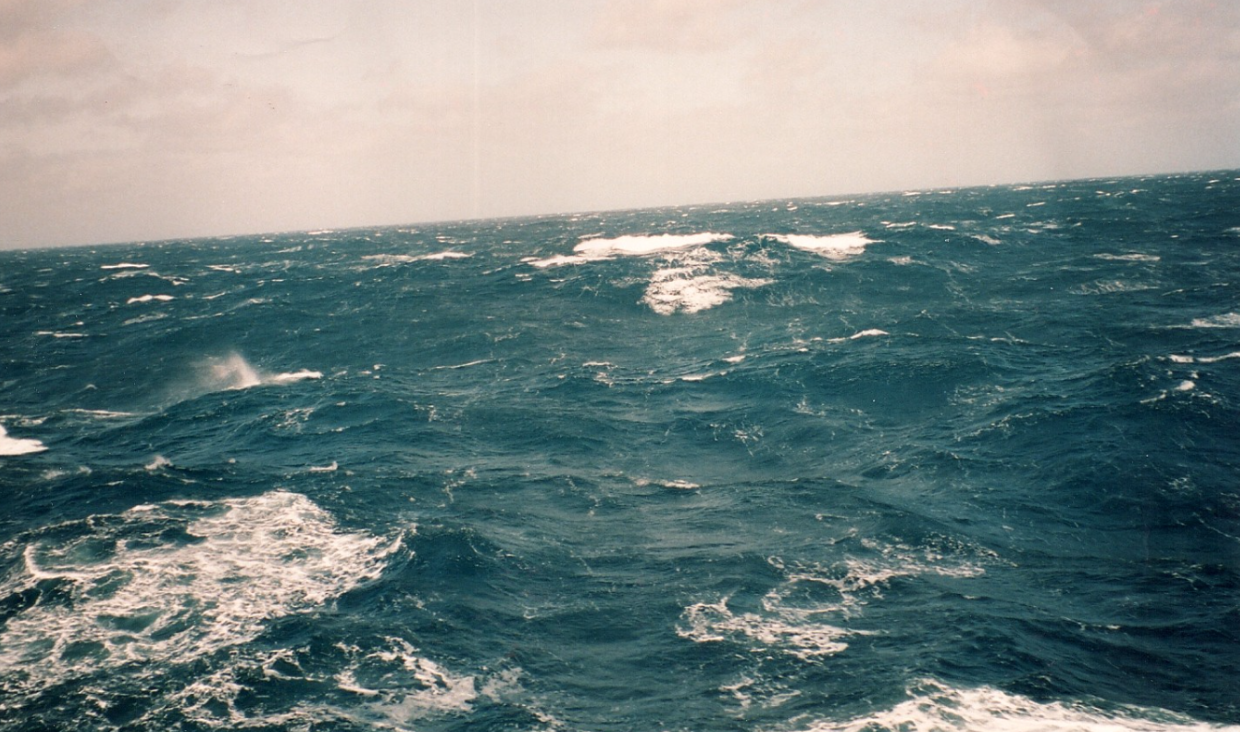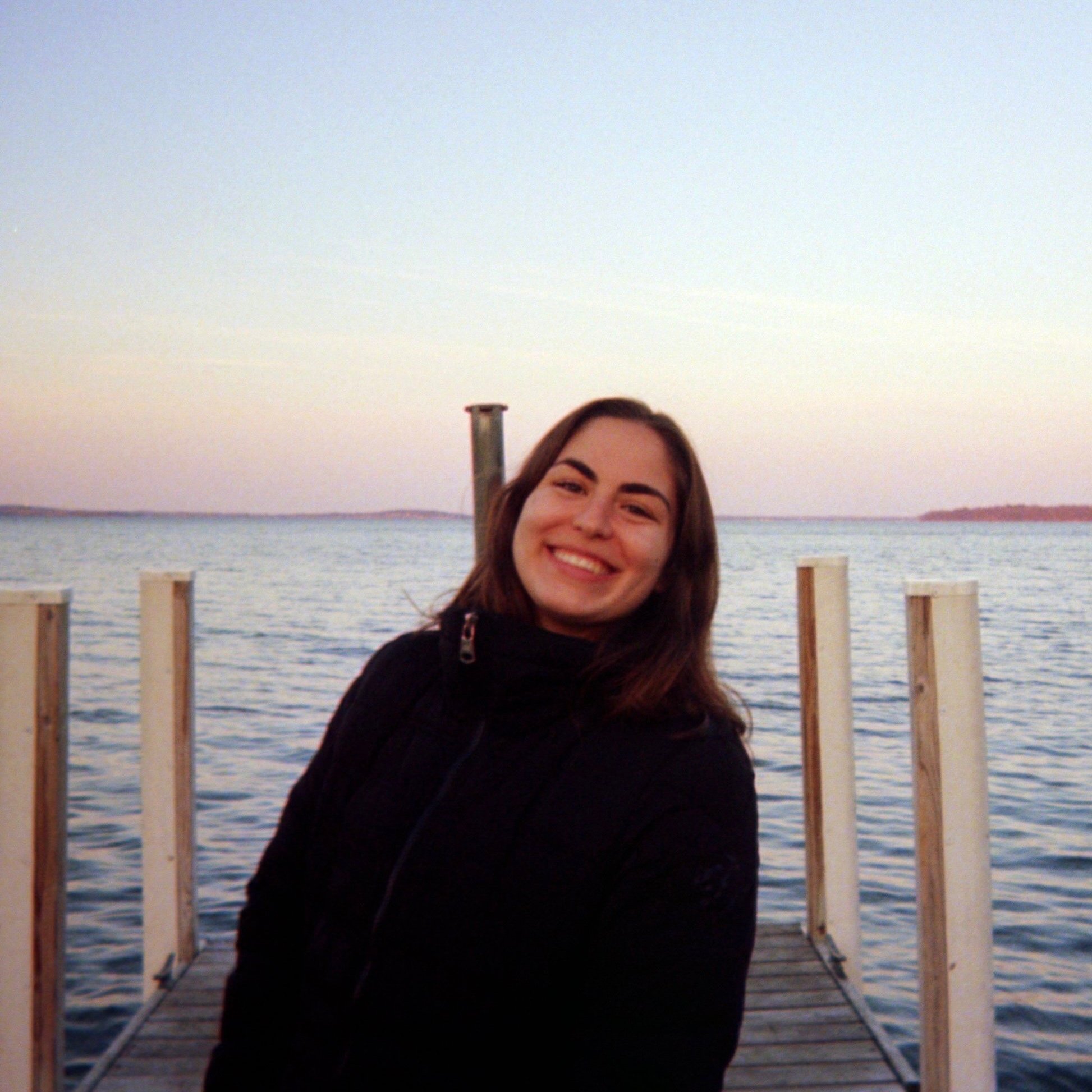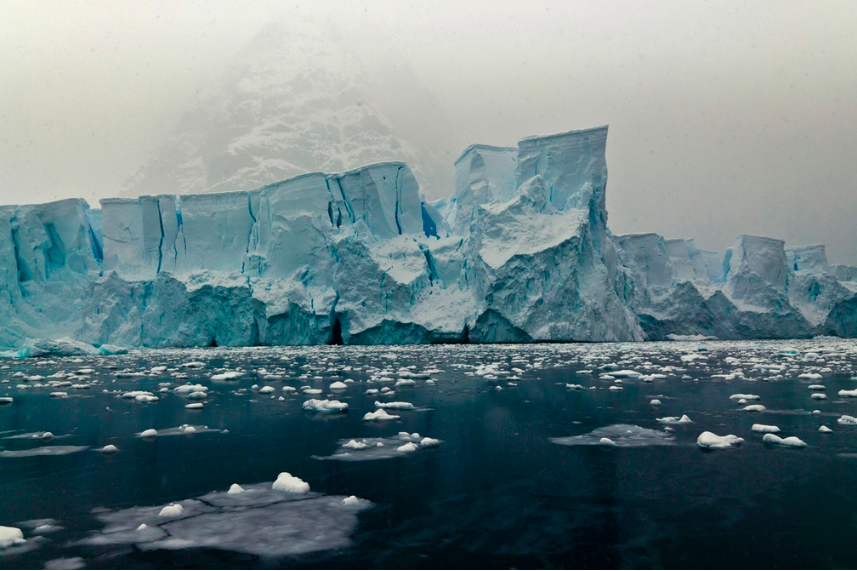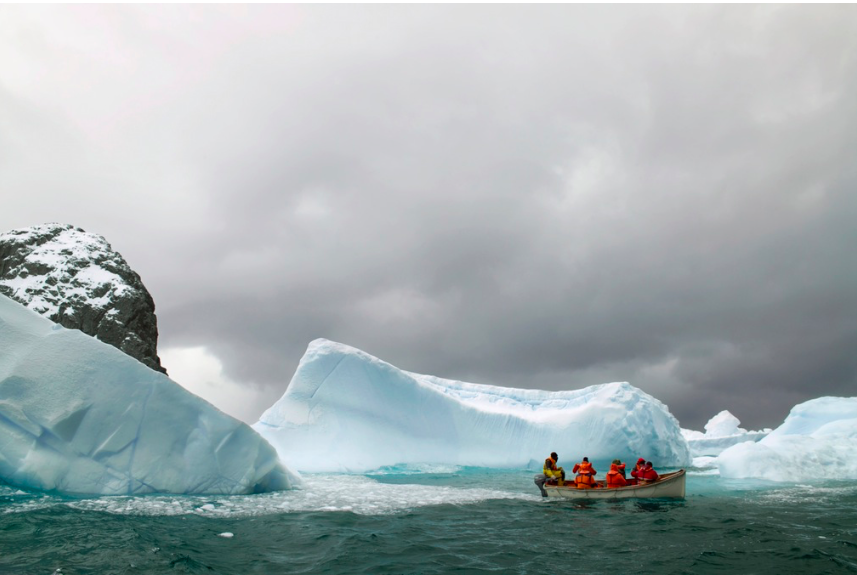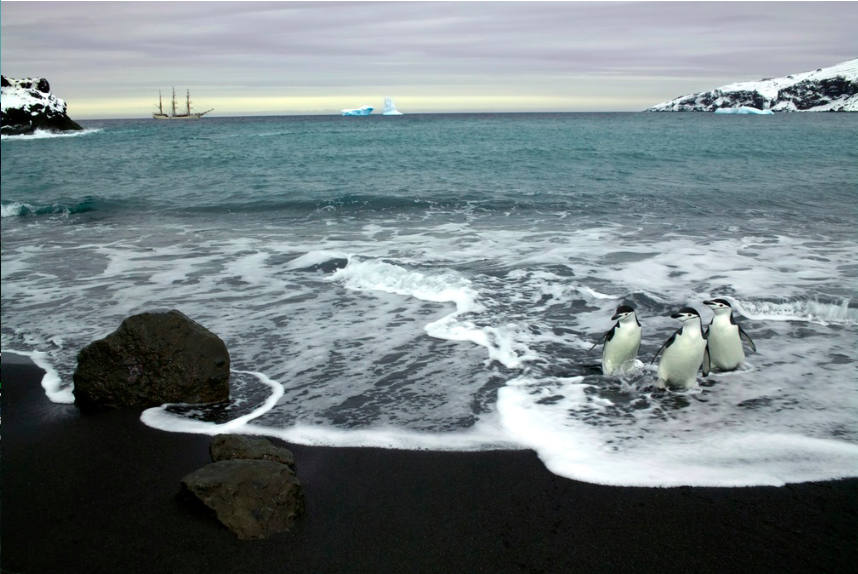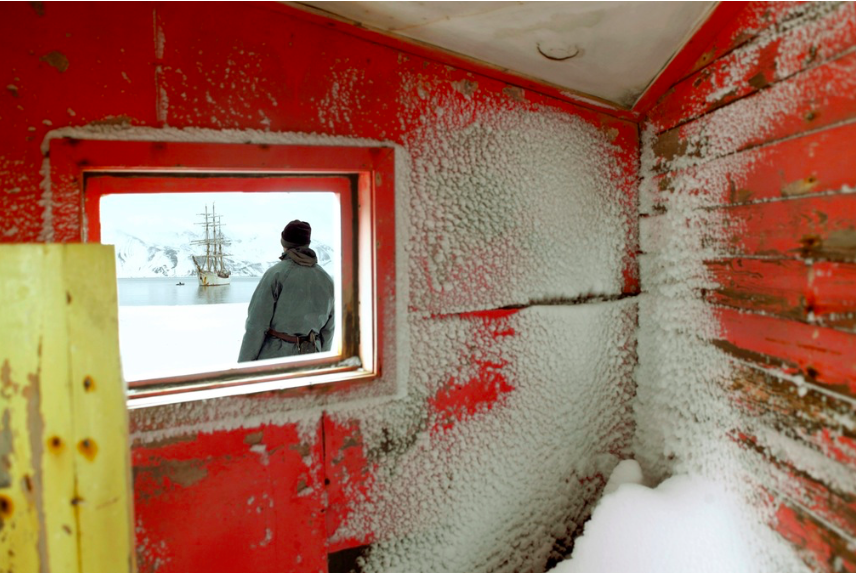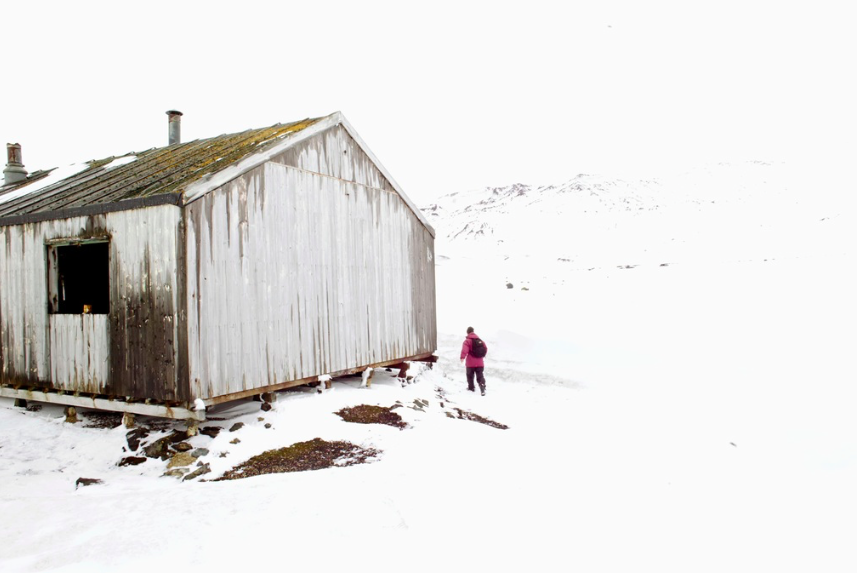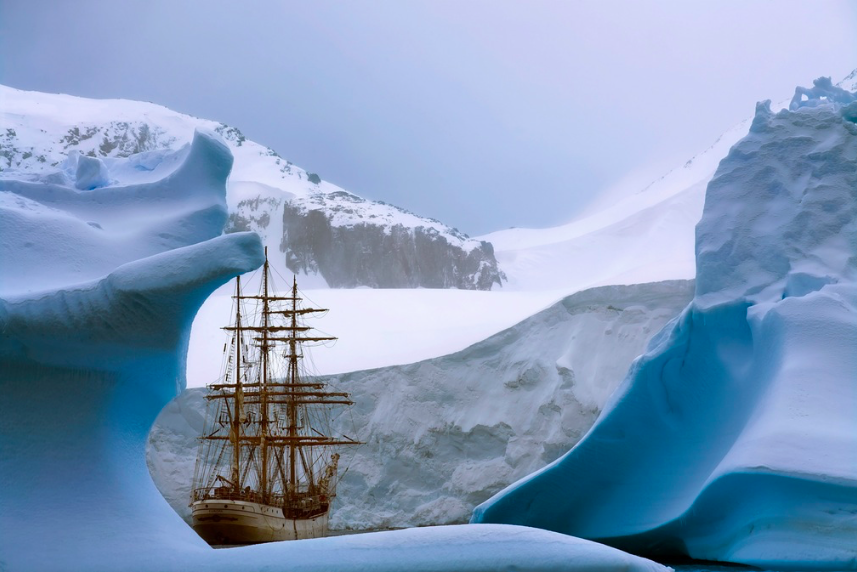Antarctica offers a unique travel experience with its diverse wildlife, extreme climate, and stunning landscapes, making it a must-see destination for adventurous travelers.
Read MoreAntarctic Tourism: Exploration or Exploitation?
As Antarctic tourism continues to surge, with over 120,000 visitors in 2024 alone, concerns over environmental impacts are mounting, particularly regarding carbon footprints and the introduction of invasive species
Read MoreEn route to Antarctica: The Unpredictable Drake Passage
Recently declared an “unforgettable” journey on Tiktok, the infamous Drake Passage is a necessity for travel lovers seeking Antarctic Adventure.
The rough conditions of the Drake Passage. Aah-Yeah. CC BY 2.0
The turbulent journey to Antarctica has rarely gotten as much attention as it did in December 2022 on TikTok. Multiple users shared their vlogs and experiences as they crossed miles to reach the icy continent. But it's less the continent itself that went viral than boat rides through the Drake Passage, a narrow strait between Antarctica and Argentina that connects the Atlantic and Pacific Oceans.
Depending on the weather, travelers passing will either experience the “Drake Lake,” a mild and almost peaceful journey, or the turbulent and rough “Drake Shake,”, which features waves that are often 20 to 25 feet tall.
According to a TikTok creator who experienced the dreaded “Drake Shake,” it took around two days for their ship to travel through the waterway and that for most of it, the boat was unsteady — to the point that passengers were “holding on to dear life” while eating breakfast at the buffet.
Folded ice in Antarctica. Trey Ratcliff. CC BY-NC-SA 2.0
The body of water is named after the famous English explorer Sir Francis Drake, one of whose ships passed near the location and discovered the connection between the Atlantic and Pacific Ocean in 1578. For wooden ships in the past the Drake Passage proved a difficult challenge, but with modern ship construction and technology the journey is now much easier, but still features its notorious bumps along the way.
One of the biggest issues for travelers undergoing the “Drake Shake” is the scourge of sea sickness. With the boat constantly tilting and rocking, getting nauseous is common. But a tip to overcome this is to know your limits — don’t be afraid to consult with an onboard doctor or take medications. Stay hydrated, don’t skip meals, and avoid alcohol. There is no shame in taking a rest.
Bringing good shoes may also make the journey smoother. These should hold snugly to your feet and help you get a good grip. One passenger who traveled across the Drake Passage said good footwear is crucial to preventing falls or slips. Some guests were visibly struggling in slippers and sandals.
But overall, when five adventurers were asked about their experience, the common consensus was that it was all worth it. Many have said it’s a journey to remember because while there may have been a few bumps on the road, the “ultimate reward is Antarctica.”
RELATED CONTENT
Michelle Tian
Michelle is a senior at Boston University, majoring in journalism and minoring in philosophy. Her parents are first-generation immigrants from China, so her love for different cultures and traveling came naturally at a young age. After graduation, she hopes to continue sharing important messages through her work
The Ice Marathon: Racing Through The Antarctica
The Ice Marathon takes place in Antarctica, known to extreme athletes as the Southernmost Marathon in the world.
Ice Marathon finish line. Rosana Katinas. CC BY-SA-4.0.
The Ice Marathon is an event geared towards committed runners who seek to compete in extreme conditions that guarantee once-in-a-lifetime experiences. Held in Antarctica, the Arctic Ice Marathon is known as the southernmost marathon in the world and is scheduled this year to occur on December 13th, 2022. It also gains most of its notoriety for the conditions under which the run takes place; sub-zero temperatures, snow and ice-covered parts of the course, and certainly the location that makes this race just as much of an adventure as it is a competition.
The race is said to take place in the area below the Ellsworth Mountains, which is the highest mountain range in the arctic and just “a few hundred miles from the South Pole”. Like any marathon, the Arctic Ice race is 26.2 miles long, and what makes this run so challenging is the climate and the terrain. The cold and the underfoot terrain, which is a term used to describe course conditions, create daunting obstacles for any participant competing.
Ellsworth Mountain range. Nasa Goddard Photo and Video. CC BY 2.0.
The first challenge that presents itself to participants is the cold. Antarctica’s temperature averages around 0 degrees celsius during the month of December, which is when the race takes place, but conditions have dropped to -25C in the past. Those who have previously participated in the Arctic Ice Marathon have been known to try and simulate the cold to prepare themselves for the climate by placing treadmills in freezers and running in the artificial cold.
Specific gear is also required. The Ice Marathon’s event website says that wind pants, a down jacket and insulated boats are absolutely necessary to compete in the event. Additional requirements for runners include wool socks, fleece pants and shirts, sunscreen and polarized sunglasses, along with a few more generally required items.
The second most challenging part of the race is the underfoot terrain. The Ice Marathon website states “the course will be groomed beforehand so it should be reasonably solid, but [is] not always”. This means that though there will be no deep snow on the course, there may be slippery ice and spots where the snow is not as tightly packed, causing the terrain to be more “energy sapping”. Advice for any athlete training for the ice marathon is to practice on sand or any other irregular or uneven terrain.
The fee to enter the marathon is $19,500. This provides the runner with their choice of race – the Arctic Ice Marathon offers a half-marathon and a full one – flights, stays and meals to and from Antarctica, and additional merchandise and photographs of the experience. The entire travel and race experience is 6 days.
Designed to entice adventure-seeking athletes, the Arctic Ice Marathon course is a prerequisite to joining the 7 Continents Marathon Club, which athletes can join once they have run and completed a marathon in every continent in the world. With over 300 members, the 7 Continents Marathon Club is an amazing way to commemorate the hardwork and dedication of marathon runners.
Ava Mamary
Ava is an undergraduate student at the University of Illinois, double majoring in English and Communications. At school, she Web Writes about music for a student-run radio station. She is also an avid backpacker, which is where her passion for travel and the outdoors comes from. She is very passionate about social justice issues, specifically those involving women’s rights, and is excited to write content about social action across the globe.
Trapped in Time: Antarctica’s Secret Blood Falls
With technology advancing at a record pace, few wonders remain that puzzle scientists. However, deep in the frigid tundra of Antarctica lies one marvel that has attracted photographers and skeptics alike.
Antarctica’s Blood Falls. arielwaldman. CC BY-NC 2.0.
In the Taylor Valley of Antarctica lies a mighty natural wonder called the Taylor Glacier. Although a spectacle in and of itself, the glacier is only an opening to an even more magnificent miracle. Sandwiched between Taylor Glacier and the underlying bedrock is a “lake” that leads to a “waterfall” known as Blood Falls. The spectacle earned its name due to the deep, murky red color of the water; the glacier releases a beautiful, bloody fountain where it has burst open. Photos of the site capture winding streams of water, which are painted with endless stripes of crimson and cream, flowing over the rocky landscape.
Geologist Thomas Griffith Taylor, for whom the Taylor Valley is named, first discovered the Blood Falls on a voyage in 1911; he was alarmed by the scarlet hue spilling from what is normally a monochrome, colorless landscape. For the remainder of the 20th century, explanations for the vermilion wonder came up short. It was not until 2015 that scientists finally concluded that the waterfall’s maroon color is due to the presence of iron oxides. Cracks in the glacier expose the iron to oxygen, causing it to turn red in the same way rusting bike spokes produce a brick-red hue. Previously, the long-standing theory for the coloring had been the presence of reddish algae, although the theory lacked sufficient evidence.
Taylor Glacier. Mike Martoccia. CC BY-SA 2.0.
However, Blood Falls still presented two seemingly insurmountable scientific dilemmas: how did the water get there in the first place, and why did the water not freeze under the weight of an enormous glacier? Luckily, researchers at the University of Alaska Fairbanks soon answered these questions: water channels brought it from an underground reservoir, and the heat released from the freezing of the glacier kept the lake in a liquid state.
In addition to the striking red color, researchers found the water to be very salty, but the source of this brine truly stumped scientists.
The team applied radio-echo sounding, the use of sound waves to measure the location of a distant object, to construct an extensive map of underground water channels. They concluded that the brine reached the falls through the channels after about 1.5 million years. The “lake” from which the brine is sourced was found to sit underneath the glacier, and has slowly absorbed iron from the bedrock. The brine seeps into the ice due to the high pressure of the glacier’s weight. Researchers concluded that the concealed lake never froze over due to the heat produced from the process of glacial freezing.
Finally, scientists stumbled upon a remarkable discovery: the lake houses microbial ecosystems that live off of sulfate in the water’s oxygen-depleted environment. The presence of the ecosystem gives scientists a vital clue to the processes of Earth’s early life forms, and provides a picture of what life could be like on oxygen-depleted planets.
To the untrained eye, Antarctica’s Blood Falls may appear to be just another facet of Mother Nature’s artistry, but any digging quickly reveals a complicated puzzle that scientists are still working to piece together.
RELATED CONTENT:
ANTARCTICA: In Search of Beauty
TRIP: ANTARCTICA: Quest to the Antarctic Circle
VIDEO: Antarctica
Ella Nguyen
Ella is an undergraduate student at Vassar College pursuing a degree in Hispanic Studies. She wants to assist in the field of immigration law and hopes to utilize Spanish in her future projects. In her free time she enjoys cooking, writing poetry, and learning about cosmetics.
Argentina Times Two: Country Declares Rule over Antarctica—and the Falklands
The nation claims disputed territories in Antarctica. Will anyone notice?
A disputed no man’s land. Trey Ratcliff. CC BY-NC-SA 2.0.
Argentina recently doubled in size, according to Argentina. President Alberto Fernandez signed into law a 650,000-square-mile expansion of Argentinian territory from its southernmost tip to the South Pole, including maritime territory in between. Though the law was signed in August, its effects are just beginning to be felt. Next school year, Argentinian children will receive textbooks proclaiming their country to be twice the size it was when their parents went to school.
The law’s legal reasoning is rooted in the United Nations Convention on the Law of the Sea, which provides President Fernandez a somewhat adequate basis for such an expansion. Argentina’s geographical shelf extends far into the sea, and the water is shallow enough to extend the country’s claim beyond the standard limit of 200 nautical miles from the nation’s coast. Though the move is grounded in international law, it has the potential to produce some controversy.
Most strikingly, the law asserts what President Fernandez calls “Argentina’s claim to the Malvinas,” also known as the Falkland Islands. Fighting erupted between Britain and Argentina in 1982 when Argentina attempted to seize control of the Falklands, only to be rebuffed by Britain’s navy. While Britain still maintains control, most Argentinians support President Fernandez’s insistence that they have a rightful claim to the islands.
Life on the ice. Christopher.Michel. CC BY 2.0.
For the time being, however, the conflict over the Falklands is as frozen as Antarctica itself. Other territorial spats are unlikely to occur. Since explorers began mapping the continent, numerous nations have claimed it as their own. International negotiations over land claims in Antarctica culminated in the Antarctic Treaty System in 1961. It provided freedom of scientific research for all nations and banned military activity, mineral mining and nuclear waste disposal.
Argentina’s new waters offer much more than the snowy lands of Antarctica. Commercial fishing is lucrative just off the British-controlled island of South Georgia. There, fishermen enjoy prime access to abundant schools of Patagonian toothfish, icefish and Antarctic krill. While the COVID-19 pandemic has stopped most tourism, Antarctica contains myriad natural wonders for tourists strong-willed enough to endure the frigid temperatures.
For now, disputed waters in Antarctica are unlikely to ignite any conflicts. The regions are sparsely populated and for the most part strategically unimportant. Even the Falkland Islands, the flashpoint of the war with Britain, has only 2,500 residents.
Scientific research at the end of the world. NASA Goddard Photo and Video. CC BY 2.0.
In fact, the brave few Argentinians who currently live in Antarctica enjoy a unique perk: safety from the coronavirus. The 400 people from the country in Antarctica reside on the only continent without a single case of COVID-19. These scientists and soldiers conduct scientific research but with far less staff than in prior years. To prevent the spread of the virus, Argentina opted to send only 400 researchers rather than the usual 2,000. Every person sent will take a test and quarantine before traveling to Argentina’s facilities, and since they won’t have many medical resources, people will be evacuated at the first sign of infection. Argentinian researchers can rest assured, though, that their president believes they tread not on a foreign continent but on their own home turf.
Michael McMarthy
is an undergraduate student at Haverford College, dodging the pandemic by taking a gap year. He writes in a variety of genres, and his time in high school debate renders political writing an inevitable fascination. Writing at Catalyst and the Bi-Co News, a student-run newspaper, provides an outlet for this passion. In the future, he intends to keep writing in mediums both informative and creative.
A tent stands alone, stark against miles and miles of snow. Dennis Rochel. Unsplash.
Even Antarctica Is Impacted by COVID-19
Antarctica is the only continent without any reported cases of COVID-19. As lucky as Antarctica’s temporary residents might consider themselves, they know that a single diagnosed case could be devastating for the 5,000 people living there. Not only is there a lack of medical equipment, but also of resources because nearly all of them have to be brought from elsewhere in the world. The continent has already had a few close calls with the virus thanks to cruise ships coming to visit. The most alarming incident occurred when almost 60% of the passengers on board the Greg Mortimer, an Antarctica-bound cruise liner, tested positive for the virus in late March.
Isolation is, in many ways, already an innate aspect of living in Antarctica. Nevertheless, those on the continent are still taking precautions against the virus. Rob McKay, director of the Antarctic Research Centre in Wellington, New Zealand, summed up the situation: “Antarctica's an isolated environment - if you had a medical emergency with a high number of people sick, you just don't have the capacity to deal with it. And with close-quarter, confined environments, it's kind of like living on a cruise ship down there.” Many researchers and scientists currently stationed on the continent have been forced to reassess their travel plans as well as their research. As the Antarctic winter approaches and the world wrestles with COVID-19, residents are growing increasingly concerned.
Life in Antarctica
There are over 80 bases established across Antarctica, each of which has its own community and is adjusting to COVID-19 independently from its neighbors. Although the bases are run by a multitude of countries and organizations, there is a universal understanding that the virus cannot reach Antarctic shores. If it does, there are plans for the virus to be dealt with immediately with methods such as isolation and contact tracing. Multiple organizations have announced that their priorities lie in keeping the stations safe for inhabitants and in continuing to operate the various base locations, even if it means redirecting resources. This reorganization means that construction and many major research projects have been canceled or postponed, leaving scores of researchers potentially cut off from a trip to the region.
For some stations, day-to-day life has continued mostly as normal. Davis Station, a research base between Australia and Africa, is home to 23 researchers who are still enjoying communicable luxuries such as a shared gym, sauna and bar. Fortunately, people who are living in Antarctica were trained before going there and taught how to live an isolated lifestyle. Nevertheless, the age of COVID-19 has brought isolation to a new level and even the smallest connections are being cut off. At the Bharati base, one of the more remote research outposts, residents say that although they typically get “regular visits” from nearby expeditions and bases, they have not seen anyone from another facility since the beginning of March. Australia has stopped shuttling people between its three Antarctic bases because they typically make stops at other nations’ places. Even in a place with no cases of COVID-19, there is a fear of inadvertently spreading the virus; people are wary of cross-continental travel, even if it's with residents who have been in Antarctica for months.
People in Antarctica have been watching the virus unfold from a distance. Some are struggling to conceptualize what a quarantined world looks like and wonder if they should practice social distancing to create good habits in anticipation of their return home. Everyone is worried about their loved ones, all of whom are at the very least 774 miles away.
Coming Home
Penguins on a stony beach on the Antarctic Peninsula while an expedition ship transfers passengers in the background. Derek Oyen. Unsplash
Beyond setting high levels of restriction in order to enter Antarctica, isolation policies in the rest of the world have affected people’s ability to leave the continent as well. Many organizations wishing to bring people back are encountering closed borders, forcing travelers to reroute. Out of anyone to face these problems, however, Antarctic researchers seem to be the best suited. Despite running into major barriers about a month ago, organizations have been working to resolve this problem and have determined various ways of getting people out of Antarctica, especially in anticipation of the Antarctic winter. As one researcher said, “...that's the kind of the thing that we have to deal with. We have to be completely adaptable because working in Antarctica is like that - conditions change, the weather changes. So, we have to be ready.”
Phoebe Jacoby
is a Media Studies major and Studio Art minor at Vassar College who believes in the importance of sharing stories with others. Phoebe likes to spend her free time reading, drawing, and writing letters. She hopes to continue developing her skills as a writer and create work that will have a positive outward effect.
Flying over the Brunt Ice Shelf. NASA/Michael Studinger. CC 2.0 https://www.flickr.com/photos/nasa_goddard/5281037316/in/photolist-Up4XjE-8ZmvJ2-93EGpw
Iceberg Twice the Size of Manhattan Threatening to Break off Antarctica at any Moment
Antarctica’s Brunt Ice Shelf, the largest in the world, will soon lose a 660 square mile, almost 500 feet thick segment of ice—almost twice the size of the city of New York. The shelf is named for David Brunt, a British meteorologist and Physical Secretary of the Royal Secretary who organized the Royal Society Expedition to the Brunt Ice Shelf in 1955.
Two cracks in the shelf have been getting wider over the past few years. This process is known as calving: the splitting and shedding of ice chunks from the edge of a glacier. Glaciologists label these cracks or crevasses in the ice sheet as chasms. Chasm 1, the first fault line on the Brunt Ice Shelf, has been present and stable for over 35 years. But just lately, this crack has been edging north as fast as 2.5 miles a year. The second break, known as the Halloween crack, is upstream from what scientists call the McDonald Ice Rumples. These rumples form when the bottom of the ice shelf, which flows downhill toward the ocean, runs up against an underwater ridge. Chasm 1 is currently about 2.5 miles away from the McDonald Ice Rumples. Soon enough these two cracks will likely intersect, creating a massive iceberg that will begin to slowly float away from Antarctica.
Scientists closely observe the Brunt Ice Shelf with instruments measuring the distortion of the ice day by day. With the help of satellite images, ground penetrating radar and on-site drone footage, scientists have been able to track the progress of Chasm 1 and the Halloween crack.
This gigantic iceberg could elevate water levels enormously. According to National Geographic, rising sea levels could produce devastating effects on coastal areas, causing wetland flooding, aquifer and agricultural soil contamination with salt, destructive erosion, and habitat loss for fish, birds and plants. In the unlikely event that all the ice sheets and glaciers on earth melted, sea levels would rise by 216 feet.
This iceberg is not even the biggest to break off of the continent of Antarctica. In 2017, a glacier the size of Delaware broke off of the Larsen-C ice sheet:around 2,250 square miles in size. The biggestchunk to break off is Iceberg B-15. It measured around 4,200 square miles, larger than the island of Jamaica. It broke off from the Ross Ice Shelf in March 2000.
The Brunt Ice Shelf is not a stranger to cracks. Cracks that form during the summer have the potential to heal again over the winter months. Though cracks are common in ice shelves, the imminent calving of the Brunt Ice Shelf is unpredictable. The potential 660 square mile iceberg could raise sea levels drastically, impacting our coastal habitats and ultimately posing dangers to human health.
AMELIA BAUMANN is an aspiring writer and editor from New Jersey. I love to travel and am intrigued with the diversity of culture around the world. I am passionate about our environment and especially keeping our oceans clean.
Video: Antarctica's Natural Wonders
The video starts in Ushuaia, Argentina and transitions to Port Williams, Chile, then rounded up Cape Horn and crossed the Drake Passage towards the Melchior Islands in Antarctica. The videographers spent 16 days in the Antarctic and got to experience the most amazing scenery and wildlife before they returned back to Ushuaia.
Rare Glimpse into Antarctic Underwater World
An underwater robot has captured a rare glimpse beneath the Antarctic sea ice, revealing a thriving, colorful world filled with coconut-shaped sponges, dandelion-like worms, pink encrusting algae and spidery starfish.
The footage was recorded on a camera attached to a Remotely Operated Vehicle (ROV) deployed by Australian Antarctic Division scientists under the sea ice at O’Brien Bay, near Casey research station in East Antarctica.
In Search of Beauty in Antarctica
Traveling on a sailing ship built in 1911, the same era the last great expeditions braved the unknown and departed for the infinite and barren landscapes of the white continent, René Koster leaves on his own voyage in search of beauty, the beauty of emptiness and cold.
Thoughts of frozen ships trapped in ice-covered seas cross my mind.
Embarking on a voyage to the South Pole, I travel in a sailing ship built in 1911, the same era the last great expeditions departed for the unknown continent. I recall images of the photographers who joined these expeditions to report of the unexplored. Fascinated by their stories I head for the same circumstances as those of the early twentieth century.
I am on a journey of longing, to a time that once was. A heroic saga, filled with hardship and adventure, in an infinite, barren land.
This series of photographs, taken with modern equipment, references the past. Personally, I feel no need for the photographs to look as if they have been created with techniques of the early 1900s. This is why I have deliberately chosen to work in color; allowing the greyscale of the landscape to emphasize the blue captured in ice. In my search for the right images, I have tried to avoid as many elements of the present time as possible; things that would remind me of everyday life.
The calm misty weather gives me a sense of desolation and makes the whole world feel smaller.
The slow rate of traveling by sailing ship influences my way of taking photographs; I seek stillness, harmony and tragedy in these otherworldly landscapes. In search of beauty, the beauty of emptiness and cold.
RENE KOSTER
René Koster's work concentrates mostly on travel photography and portraits for magazines around the globe. Work from his Antarctica project was awarded The Travel Photographer of the Year. Check out his website here.

